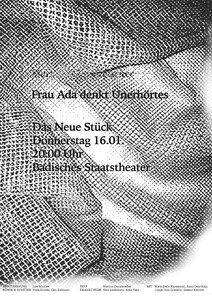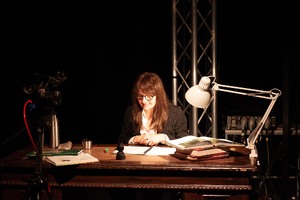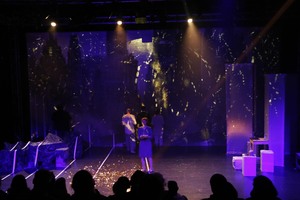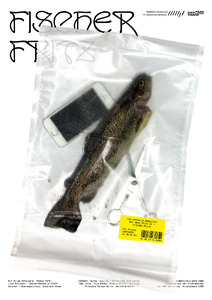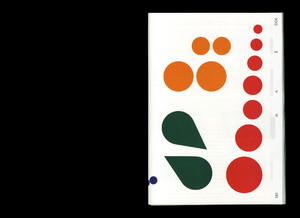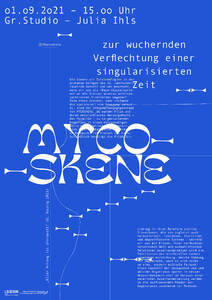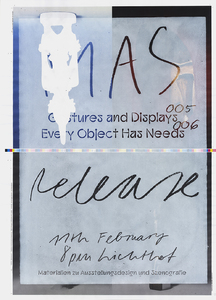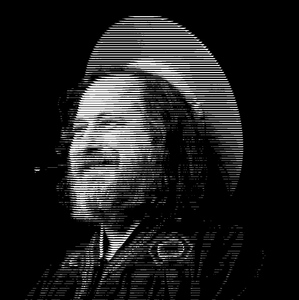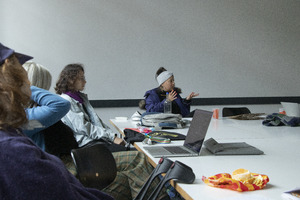Sets
125 Inhalte
- Seite 1 von 11
DNS #64
- Titel
- DNS #64
- Untertitel
- Frau Ada denkt Unerhörtes
- Autor/in
- Beschreibung (de)
- Das neue Stück „Frau Ada denkt Unerhörtes“ handelt von der ersten Programmiererin der Welt, Ada Lovelace. Es beschreibt Adas Leben in zwei Teilen: Einem biografischen aber stark verfremdeten ersten Teil, der durch seine Dialoge und Besetzung eher Traumhaft wirkt, und einem realistisch anmutenden zweiten Teil, in dem eine Zukunft erdacht wird, in der eine der Maschinen, die Ada einst erfand, die Macht über die Menschheit an sich nimmt.
Unsere Kulisse bestand aus einem leicht durchscheinenden Vorhang, der die Bühne in der Mitte teilt. Im ersten Teil des Stücks saßen die Zuschauer auf der Tribüne, für den zweiten Teil wechselten sie die Seite des Vorhangs und saßen dann auf niedrigen Podesten auf der Rückseite der Bühne.
Um die Traumhaftigkeit des ersten Teils darzustellen, zeigten wir dort nur die Schauspielerin von Ada vor dem Vorhang, die anderen drei Schauspieler, welche die Figuren der Mutter und zweier Puppen darstellten, befanden sich hinter dem Vorhang und waren nur durch Schatten auf diesem zu sehen. Das Stück lässt offen, ob Ada mit echten Personen spricht, ob die Ereignisse wirklich passiert sind, oder ob alles nur in Adas Kopf stattfindet. Dieses Verschwimmen aus Fiebertraum und Wirklichkeit wurde durch die Schatten auf dem Vorhang artikuliert. Um dem Publikum dennoch ein Gefühl für die echte Ada Lovelace zu geben, wurden immer wieder Fakten aus ihrem Leben auf den Vorhang projiziert.
Im zweiten, sehr realistisch anmutenden Teil, bei dem sich die Zuschauer auf der anderen Seite des Vorhangs befinden, stehen die drei Schauspieler nun auf der Publikumsseite des Vorhangs in den Rollen dreier Wissenschaftler. Ada, jetzt als Roboter, steht leicht beleuchtet hinter dem Vorhang und scheint wie eine Traumvorstellung trüb durch den Stoff. In dem Moment, als sie zu eigenständigem Leben erwacht, wechselt sie die Seite des Vorhangs, tritt aus dem Traum und übernimmt die Realität.
Neben dem Verschwimmen von Traum und Realität, ist das Stück ebenfalls geprägt von Machtverhältnissen: Im ersten Teil wird Ada von ihrer Mutter und ihren vielen Krankheiten dominiert und muss viel liegen. Die Schauspielerin sitzt im gesamten ersten Teil auf dem Boden. Der Schatten der Mutter hinter ihr ist groß und bedrohlich. Das Publikum sitzt in einer erhöhten Position auf der Tribüne und schaut auf Ada herab.
Im zweiten Teil übernimmt Ada in Form eines Roboters die Macht, das Publikum wird ihr untergeordnet und sitzt auf niedrigen Podesten fast auf dem Boden. Die Wissenschaftler werden von Ada überwunden und verlassen nach und nach den Lichtkegel der Bühne.
- Das neue Stück „Frau Ada denkt Unerhörtes“ handelt von der ersten Programmiererin der Welt, Ada Lovelace. Es beschreibt Adas Leben in zwei Teilen: Einem biografischen aber stark verfremdeten ersten Teil, der durch seine Dialoge und Besetzung eher Traumhaft wirkt, und einem realistisch anmutenden zweiten Teil, in dem eine Zukunft erdacht wird, in der eine der Maschinen, die Ada einst erfand, die Macht über die Menschheit an sich nimmt.
- Beschreibung (en)
- The new play "Frau Ada denkt Unerhörtes" is about the world's first female programmer, Ada Lovelace. It describes Ada's life in two parts: A biographical but heavily distorted first part, which seems rather dreamlike due to its dialog and cast, and a realistic-seeming second part, in which a future is imagined in which one of the machines Ada once invented takes power over humanity.
Our backdrop consisted of a slightly translucent curtain that divided the stage in the middle. In the first part of the play, the audience sat on the bleachers; for the second part, they changed sides of the curtain and then sat on low platforms at the back of the stage.
In order to portray the dreamlike nature of the first part, we only showed Ada's actress in front of the curtain; the other three actors, who played the characters of the mother and two puppets, were behind the curtain and could only be seen through shadows on it. The play leaves it open as to whether Ada is talking to real people, whether the events really happened or whether everything is just taking place in Ada's head. This blurring of fever dream and reality was articulated by the shadows on the curtain. In order to give the audience a feeling for the real Ada Lovelace, facts from her life were projected onto the curtain again and again.
In the second, very realistic-looking part, in which the audience is on the other side of the curtain, the three actors now stand on the audience side of the curtain in the roles of three scientists. Ada, now as a robot, stands slightly illuminated behind the curtain and seems to be clouding through the fabric like a dream. The moment she awakens to independent life, she changes sides of the curtain, steps out of the dream and takes over reality.
In addition to the blurring of dream and reality, the play is also characterized by power relations: In the first part, Ada is dominated by her mother and her many illnesses and has to lie down a lot. The actress sits on the floor throughout the first part. The shadow of her mother behind her is large and threatening. The audience sits in an elevated position on the stand and looks down on Ada.
In the second part, Ada takes over in the form of a robot, the audience is subordinated to her and sits on low platforms almost on the floor. The scientists are overcome by Ada and gradually leave the light cone of the stage.
- The new play "Frau Ada denkt Unerhörtes" is about the world's first female programmer, Ada Lovelace. It describes Ada's life in two parts: A biographical but heavily distorted first part, which seems rather dreamlike due to its dialog and cast, and a realistic-seeming second part, in which a future is imagined in which one of the machines Ada once invented takes power over humanity.
- Typ des Projekts/Werks
- Schlagworte
- Datierung
- 16.01.2020
- Mitwirkende
- Sprache
- Ort: Institution
- Ort
- Studiobühne
- Stadt
- Land
- Beteiligte Institution(en)
- Bemerkungen
- Szenische Lesung
Bühne & Kostüme: Paula Klotzki, Cara Kollmann
Regie: Liss Scholtes
Dramaturgie: Nele Lindemann, Anna Haas
Mit: Marie-Joelle Blazejewski, Anna Gesa-Raija Lappe, Tom Gramenz, Gunnar Schmidt
- Szenische Lesung
- Titel
- DNS #64
- Projektleiter/in
- Semester
- Studiengang
- Lehrveranstaltung
- Importiert am
- 19.12.2023
- Übergeordnete Sets
- 1
- Set enthält
- 0 8
DNS #65
- Titel
- DNS #65
- Untertitel
- Bookpink
- Autor/in
- Beschreibung (de)
- In sieben komisch-poetischen Miniaturen beschreibt Caren Jeß menschliche Abgründe im Gewand von Federtieren wie dem Dreckspfau, der Sumpfmeise, tanzenden Flamingos oder dem Bussard im Beton der Vernunft. Ein Stück voller Humor, subtilem Wortwitz und draller Situationskomik.
- Beschreibung (en)
- In seven comic-poetic miniatures, Caren Jeß describes human abysses in the guise of feathered creatures such as the peacock, the marsh tit, dancing flamingos or the buzzard in the concrete of reason. A play full of humor, subtle wordplay and gritty situation comedy.
- Typ des Projekts/Werks
- Schlagworte
- Datierung
- 27.02.2020
- Mitwirkende
- Sprache
- Dauer
- 1 Stunde 30 Minuten
- Ort: Institution
- Ort
- Studio
- Stadt
- Land
- Beteiligte Institution(en)
- Bemerkungen
- Szenische Lesung und Autor*innengespräch
Bühne/Kostüm: Paula Klotzki, Jana Trampert, Cara Kollmann, Julia Ihls
Dramaturgie: Nele Lindemann, Anna Haas
Regie: Tobias Döhmer
SchauspielerInnen: Antonia Mohr, Jannek Petri, Alisa Kunina, Pål Fredrik Kvale, Constantin Petry
Plakat: Julia Ihls
- Szenische Lesung und Autor*innengespräch
- Titel
- DNS #65
- Projektleiter/in
- Semester
- Studiengang
- Lehrveranstaltung
- Importiert am
- 19.12.2023
- Übergeordnete Sets
- 1
- Set enthält
- 0 4
DNS #59
- Titel
- DNS #59
- Untertitel
- Worte
- Autor/in
- Beschreibung (de)
- In einer unbestimmten Zukunft sind nur noch Menschen mit einem besonderen Sprach-Gen privilegiert. Wer dieses Gen nicht aufweist, lebt außerhalb eines urbanen Zentrums, in Ruinen, mit rudimentärer Sprache, auf den evolutionären Grad eines Insekts reduziert. Wurm ist sprachlich begabt und schlüpft täglich durch die Absperrungen, die die Kolonien voneinander trennen, um im Zentrum zu arbeiten. Doch sein Vorgesetzter hat schon Verdacht geschöpft. Wie Sprache, Macht und die Herausbildung totalitärer Systeme zusammenhängen, davon schreibt Maria Milisavljevic in ihrem Stück Worte.
- Beschreibung (en)
- In an indefinite future, only people with a special language gene will be privileged. Those without this gene live outside an urban center, in ruins, with rudimentary language, reduced to the evolutionary level of an insect. Wurm is linguistically gifted and slips through the barriers separating the colonies every day to work in the center. But his superior has already become suspicious. Maria Milisavljevic writes about how language, power and the development of totalitarian systems are connected in her play Worte.
- Typ des Projekts/Werks
- Schlagworte
- Datierung
- 01.05.2019 - 15.05.2019
- Mitwirkende
- Sprache
- Ort: Institution
- Ort
- Studiobühne
- Stadt
- Land
- Beteiligte Institution(en)
- Bemerkungen
- Szenische Lesung und Autor*innengespräch
EINRICHTUNG Tobias Dömer
BÜHNE & KOSTÜME Lena Breitmoser, Carina Fenderich*
DRAMATURGIE Nele Lindemann MIT Emons, Hübschmann – Koch, Schumacher, Wagner
- Szenische Lesung und Autor*innengespräch
- Titel
- DNS #59
- Projektleiter/in
- Semester
- Studiengang
- Lehrveranstaltung
- Importiert am
- 19.12.2023
- Übergeordnete Sets
- 1
- Set enthält
- 0 9
DNS
- Titel
- DNS
- Typ des Projekts/Werks
- Schlagworte
- Sprache
- Stadt
- Land
- Titel
- DNS
- Studiengang
- Importiert am
- 19.12.2023
- Übergeordnete Sets
- 0
- Set enthält
- 12 0
MAS 006
- Titel
- MAS 006
- Untertitel
- Every Object Has Needs
- Autor/in
- Beschreibung (de)
- Im Jahr 2014 präsentierte das Weltkulturen Museum in Frankfurt eine Ausstellung mit dem Titel "Foreign Exchange (or the stories you wouldn't tell a stranger)". Die von Clémentine Deliss und Yvette Mutumba - damals Direktorin bzw. Kuratorin des Museums - kuratierte Ausstellung umfasste einen Überblick über die fotografische Dokumentation der rund 67.000 ethnografische Artefakte umfassenden Sammlung des Museums. Die Bilder stammen von Studiofotografen, die vom Museum beauftragt wurden, und von hauseigenen Fotografen.
Eine Begleitpublikation zur Ausstellung enthält die Niederschrift einer Gruppendiskussion zwischen eingeladenen Künstlern, Schriftstellern, Anthropologen und anderen Kommentatoren, die im Rahmen der Ausstellung organisiert wurde. Hier werden diese historischen Fotografien heftig kritisiert. Als besonders problematisch wird ihre über mehrere Jahrzehnte anhaltende Tendenz angesehen, ethnografische Artefakte isoliert vor einfarbigen, hellen, "ethnisch" gefärbten Hintergründen abzubilden. Diese spezifische Ästhetik wird in der Diskussion als eine Art Kompensation für das außerordentliche Fehlen von Wissen über die Herkunft der abgebildeten Artefakte interpretiert, von denen viele in einer intensiven Periode der Aktivität während der Kolonialzeit durch den Gründungsdirektor des Museums, Bernard Hagen, erworben wurden.
Diese Ausgabe von MAS unternimmt einige elementare bibliografische Schritte, um die Rhetorik der Kritik in "Foreign Exchange" zu qualifizieren, und in Richtung grundlegender Alle in dieser Ausgabe von MAS gezeigten Bilder stammen aus den Büchern, die in der Datenbank vorgestellt werden. Forschung, die Deliss fordert, wenn sie schreibt: "Bis heute gab es keine kritische Analyse der Art und Weise, in der sogenannte Stammeskunstobjekte oder Ethnografika fotografiert wurden, sobald sie von ihrem ursprünglichen Produktionsort entfernt wurden.
Bei dem hier vorgestellten Material handelt es sich um visuelle Untersuchungen, die im Rahmen eines von James Langdon initiierten Seminars an der HfG Karlsruhe im Jahr 2018 durchgeführt wurden. Eine Gruppe von zehn Teilnehmern analysierte eine Sammlung von 56 Ethnographica-Büchern, die zwischen den 1960er Jahren - als der Vollfarbdruck im Museumsbereich üblich wurde - und dem aktuellen Jahrzehnt veröffentlicht wurden. Jedes Jahrzehnt war mit etwa zehn Titeln vertreten, etwa zur Hälfte aus Europa und zur Hälfte aus den USA. Die Sammlung wurde von internationalen ethnographischen Buchhändlern zusammengestellt und ist somit unabhängig von den Interessen der Verlage und der Museen und Einzelpersonen, deren Sammlungen vertreten sind. Innerhalb dieser Parameter wurden die einzelnen Titel visuell ausgewählt, und zwar auf der Grundlage von Studiofotografien afrikanischer Artefakte, die mit der in "Foreign Exchange" beschriebenen Ästhetik übereinstimmen. Es wird daher nicht versucht, das Ausmaß dieser ästhetischen Tendenzen im Bereich der ethnografischen Veröffentlichungen insgesamt zu quantifizieren. Trotz ihres notwendigerweise bescheidenen Umfangs ist allein die geographische und historische Streuung der Sammlung ein Indiz dafür, dass diese Ästhetik weit verbreitet und offenbar unumstritten war und keineswegs nur im Kontext des Weltkulturen Museums oder der deutschen Ethnographica zu finden ist.
Die gesammelten Bücher enthalten insgesamt 10.189 Bilder. Die Teilnehmer analysierten die Bücher direkt und erstellten eine Datenbank mit den bibliografischen Angaben: Umfang, Abmessungen und Themen der Bücher sowie Angaben zu den Fotografien selbst: Farben und Art der verwendeten Hintergründe, Merkmale der Beleuchtung und des Ausschnitts sowie Aspekte der grafischen Gestaltung, die für die Darstellung relevant sind. Die Arbeit wurde dann durch "Anfragen" an diese Datenbank fortgesetzt, wobei Teilmengen von Bildern ermittelt wurden, die für die Diskussion zusammengestellt werden sollten. Die vergleichende visuelle Arbeit erfolgte manuell - nicht am Computer - durch Sortieren und Gruppieren der Bilder auf großen Tabellen. Sieben dieser Anfragen werden auf den folgenden Seiten vorgestellt, wobei die Methodik in kurzen Untertiteln beschrieben wird.
Die Diskussionen wurden durch zeitgenössische und historische Lektüre ergänzt, und während des Seminars wurde die laufende Arbeit durch regelmäßige Beiträge von Gästen, darunter Clémentine Deliss, Jan Hoek, Sarah Owens und Jelly Sarah Kouablan, begleitet. Ihre Kommentare machten uns nur allzu bewusst, dass unsere Position in einer europäischen Kunstschule und unser Vertrauen auf bibliografische Methoden uns trotz unserer besten Absichten dazu verleiteten, den westlichen Blick zu reproduzieren, selbst wenn wir ihn aktiv kritisierten.
- Im Jahr 2014 präsentierte das Weltkulturen Museum in Frankfurt eine Ausstellung mit dem Titel "Foreign Exchange (or the stories you wouldn't tell a stranger)". Die von Clémentine Deliss und Yvette Mutumba - damals Direktorin bzw. Kuratorin des Museums - kuratierte Ausstellung umfasste einen Überblick über die fotografische Dokumentation der rund 67.000 ethnografische Artefakte umfassenden Sammlung des Museums. Die Bilder stammen von Studiofotografen, die vom Museum beauftragt wurden, und von hauseigenen Fotografen.
- Beschreibung (en)
- In 2014 the Weltkulturen Museum in Frankfurt presented an exhibition titled ‘Foreign Exchange (or the stories you wouldn’t tell a stranger)’. Curated by Clémentine Deliss and Yvette Mutumba — at that time director and curator of the museum, respectively — the exhibition included a survey of the museum’s photographic documentation of its collection of around 67.000 ethnographic artefacts. These images were made by studio photographers commissioned by the museum and by in-house photographers.
A publication accompanying the exhibition presents the transcript of a group discussion between invited artists, writers, anthropologists, and other commentators, organised in the context of the exhibition. Here these historical photographs are heavily criticised. Considered particularly problematic is their tendency — consistent over several decades — to depict ethnographic artefacts in isolation against plain, bright, ‘ethnic’ coloured backgrounds. This specific aesthetic is interpreted in the discussion as a kind of compensation for an extraordinary absence of knowledge about the provenance of the depicted artefacts, many of which were acquired in an intense period of activity during the colonial era by the museum’s founding director, Bernard Hagen.
This issue of MAS makes some elementary bibliographic moves to qualify the rhetoric of the critique in ‘Foreign Exchange’, and toward foundational All images shown in this issue of MAS originate from the books which are presented in the database.research that Deliss calls for when she writes: ‘To date there has been no critical analysis of the manner in which so-called tribal art objects or ethno-graphica have been photographed once removed from their original location of production.’
The material presented here is visual research produced during a seminar initiated by James Langdon at HfG Karlsruhe in 2018. A group of 10 participants analysed a collection of 56 books of ethnographica published between the 1960s — when full-colour printing began to be commonly used in museum publishing — and the present decade. Each decade was represented by around ten titles, roughly half from Europe, half from the USA. The collection was assembled through international ethnographic book dealers, and as such is independent of the interests of any of the books’ publishers and the museums and individuals whose collections are represented. Within these parameters, the individual titles were selected visually, based on their inclusion of studio photographs of African artefacts that correspond with the aesthetics described in ‘Foreign Exchange’. No attempt is made, therefore, to quantify the extent of these aesthetic tendencies in the field of ethnographic publishing overall. Despite its necessarily modest size, the geographical and historical spread of the collection alone is indicative of the fact that these aesthetics have been commonly used, apparently without controversy, and are by no means particular to the contexts either of the Weltkulturen Museum, or German ethnographica.
The collected books contain a total of 10.189 images. Participants analysed the books directly, creating a database of their bibliographical details: their extent, dimensions, and subjects; and details of the photographs themselves: the colours and types of backgrounds used, the characteristics of lighting and cropping, and aspects of graphic design relevant to their presentation. Work then proceeded through ‘enquiries’ directed to this database, identifying subsets of images to be compiled for discussion. Comparative visual work was done manually — not at the computer — by sorting and grouping images on large tables. Seven of these enquiries are presented on the following pages, with brief captions describing their methodologies.
Discussions were supplemented by contemporary and historical readings, and during the seminar ongoing work was socialised through regular input from guests, including Clémentine Deliss, Jan Hoek, Sarah Owens and Jelly Sarah Kouablan. Their commentaries made us all too aware that despite our best intentions, our position in a European art school and our reliance on bibliographical methods led us continually to reproduce the Western gaze even as we actively critiqued it.
- In 2014 the Weltkulturen Museum in Frankfurt presented an exhibition titled ‘Foreign Exchange (or the stories you wouldn’t tell a stranger)’. Curated by Clémentine Deliss and Yvette Mutumba — at that time director and curator of the museum, respectively — the exhibition included a survey of the museum’s photographic documentation of its collection of around 67.000 ethnographic artefacts. These images were made by studio photographers commissioned by the museum and by in-house photographers.
- Typ des Projekts/Werks
- Schlagworte
- Mitwirkende
- Sprache
- Abmessungen
- DinA 4
- Ort: Institution
- Stadt
- Land
- Bemerkungen
- Heft 6: Every Object Has Needs
Bestellung unter mas@hfg-karlsruhe.de
- Heft 6: Every Object Has Needs
- Titel
- MAS 006
- Projektleiter/in
- Semester
- Lehrveranstaltung
- Importiert am
- 18.12.2023
- Übergeordnete Sets
- 1
- Set enthält
- 0 10
MYCOSKENE
- Titel
- MYCOSKENE
- Titel (en)
- Mycoskene
- Untertitel
- Zur wuchernden Verflechtung einer singularisierten Zeit
- Untertitel des Projekts/Werks (en)
- Or on the rampant interweaving of a singularized time
- Autor/in
- Beschreibung (de)
- MYCOSKENE ist eine material-theoretische Verflechtung rund um das Thema Mycelium, dem unterirdischen Hyphengeflecht der Pilze. Ob als sozio-philosophische Metapher, Bau- und Gestaltungsmaterial oder in Form einer multi-medialen Rauminstallation – in ihrer Arbeit folgte die Szenografin und Konzepterin Julia Ihls über 8 Monate den fein verwobenen Strukturen jener Organismen, die durch ihre eigene Zeitlichkeit und Qualitäten zu maßgeblichen Co-Gestaltenden wurden.
- Beschreibung (en)
- MYCOSKENE is a material-theoretical interweaving around the theme of mycelium, the subterranean network of hyphae of fungi. Whether as a socio-philosophical metaphor, building and design material or in the form of a multi-media spatial installation - in her work, scenographer and conceptual designer Julia Ihls followed the finely interwoven structures of these organisms for over 8 months, which became decisive co-creators through their own temporality and qualities.
- Kategorie
- Typ des Projekts/Werks
- Schlagworte
- Datierung
- 01.09.2021 - 03.09.2021
- Mitwirkende
- Sprache
- Ort: Institution
- Ort
- Großes Studio
- Stadt
- Land
- Internetlinks
- Walkthrough Video: https://vimeo.com/653230334
Doku Film:
Instagram: @mycoskene https://www.instagram.com/mycoskene/?hl=de
Website: https://mycoskene-.hotglue.me/
- Walkthrough Video: https://vimeo.com/653230334
- Titel
- MYCOSKENE
- Projektleiter/in
- Semester
- Studiengang
- Typ der Abschlussarbeit
- Importiert am
- 14.12.2023
- Übergeordnete Sets
- 1
- Set enthält
- 0 11
MAS
- Titel
- MAS
- Autor/in
- Beschreibung (de)
- "Materialien zu Ausstellungsdesign und Szenografie" ist eine neue Publikationsreihe des Fachbereichs Ausstellungsdesign und Szenografie der HfG Karlsruhe. Sie setzt sich mit der Gestaltung von narrativen Räumen als kritischer Designpraxis auseinander. Materialien zu Ausstellungsdesign und Szenografie ist als fortlaufende Materialsammlung angelegt, in der Beiträge zu Diskussionen in unserem Fachgebiet zusammengetragen und zugänglich gemacht werden. Wir betrachten die einzelnen Ausgaben als Ausstellungsräume und die bedruckten Seiten als Displays. Dabei geht es uns nicht vorrangig um die Produktion neuer Beiträge sondern um bestehende Materialien, die durch ihre Auswahl, Kombination, Kontextualisierung oder Kommentierung, sowie ihre gestaltete Darstellung in Printform neue Zusammenhänge und Perspektiven herstellen.
- Beschreibung (en)
- "Materials on Exhibition Design and Scenography" is a new publication series from the Department of Exhibition Design and Scenography at the HfG Karlsruhe. It deals with the design of narrative spaces as a critical design practice. Materials on Exhibition Design and Scenography is designed as an ongoing collection of material in which contributions to discussions in our field are compiled and made accessible. We view the individual issues as exhibition spaces and the printed pages as displays. We are not primarily concerned with the production of new contributions, but rather with existing materials that create new contexts and perspectives through their selection, combination, contextualization or commentary, as well as their designed presentation in print form.
- Typ des Projekts/Werks
- Schlagworte
- Sprache
- Technik/Verfahren/Formate
- DinA 4
- Ort: Institution
- Stadt
- Land
- Bemerkungen
- Seit 2016
Heft 1: Judith Barry
Heft 2: Stanislaw Zamecznik
Heft 3: László Moholy-Nagy
Heft 4: Jan van Toorn
Heft 5: Gestures and Displays
- Seit 2016
- Titel
- MAS
- Projektleiter/in
- Lehrveranstaltung
- Importiert am
- 14.12.2023
- Übergeordnete Sets
- 0
- Set enthält
- 6 1
Who cares?
- Titel
- Who cares?
- Titel (en)
- Who Cares?
- Untertitel
- Digitale Sozialität, Infrastrukturen der Fürsorge und konviviale Technologien
- Untertitel des Projekts/Werks (en)
- Digital sociality, care infrastructure and convivial technology
- Autor/in
- Beschreibung (de)
- Die Hackerkultur verbindet Theorie und Praxis (nach hand-on Prinzipien) und einen neuen Ansatz für Kulturmaterialien (»information wants to be free«), der nicht nur eine andere Epistemologie, sondern auch einen neuen politischen Diskurs über Digitalität, Geräte und Menschen impliziert. Das Verhältnis zwischen Technik und Politik dieser Gruppe wird im ersten Kapitel analysiert: Zuerst wird die Entstehung proprietärer Software betrachtet, dann die Unterschiede zwischen Open Source und freier Software, und wie im letzten die Privateigentum und die soziale Beziehung zwischen Programmen, Benutzern und Entwicklern radikal in Frage gestellt werden. Später wird diese Beziehung anhand von Hanna Arendts _Die conditio humana_ in Bezug auf Arbeit, Herstellen und Handlen, Notwendigkeit und Freiheit, die die Bedingungen für Politik schaffen, weiter diskutiert. Im zweiten Kapitel wird das Konzept der Konvivialität (Ivan Illich) vorgestellt und diskutiert. Diese Idee wird später in der Wartung als infrastrukturelle Vorsorge weiterentwickelt und als ein zentrales Element digitaler Technologien vorgeschlagen, das weiter diskutiert werden sollte. Diese Konstellation des Denkens und Handelns, des Spielens und Lernens, des Experimentierens und der Übernahme von Verantwortung sowie der Politik und der sozialen Beziehungen sollte in der Technologiedebatte eine wichtige Rolle spielen.
- Beschreibung (en)
- Hacker culture connects theory and praxis (following hand-on principles) and a new approach to culture materials (»information wants to be free«), that implies not only a different epistemology, but also a new political discourse on digitality, devices, and people. The relation between technic and politic of this group is analyzed in the first chapter: first focusing on the emergence of proprietary software; then considering the differences between open source and free software, the last one challenging radically the notion of private property and the social relation among programs, users, and developers. Later on, reading Hanna Arendts "The Human condition", the relation will be further discussed in terms of labor, work and action, necessity and freedom, which establish the conditions for politics. In the second chapter, the concept of conviviality (Ivan Illich) is introduced and discussed. This idea is later developed in maintenance as infrastructural care and proposed as a central element of digital technologies that should be further discussed. This constellation of thinking and acting, playing and learning, experimenting and taking responsibility, as well as politics and social relations should play a prominent role in the debate about technology.
- Kategorie
- Typ des Projekts/Werks
- Schlagworte
- Datierung
- 30.03.2023
- Sprache
- Titel
- Who cares?
- Projektleiter/in
- Semester
- Studiengang
- Typ der Abschlussarbeit
- Importiert am
- 30.11.2023
- Übergeordnete Sets
- 0
- Set enthält
- 0 4
Vom Nutzen der Kunst
- Titel
- Vom Nutzen der Kunst
- Titel (en)
- On the benefits of art
- Autor/in
- Beschreibung (de)
- In der gemeinsamen Gesprächsreihe "Vom Nutzen der Kunst" von ZKM und HfG, laden wir internationale Gäste aus Philosophie, Literatur und Kunst zum offenen Austausch mit den Hochschulangehörigen, den Mitarbeitenden des ZKM und der Karlsruher Bevölkerung ein.
- Beschreibung (en)
- In the joint series of talks between ZKM and HfG, we invite international guests from the fields of philosophy, literature and art to an open exchange with members of the university, ZKM staff and the people of Karlsruhe.
- Typ des Projekts/Werks
- Schlagworte
- Datierung
- 16.11.2023
- Ort: Institution
- Ort
- Media Lounge
- Stadt
- Land
- Titel
- Vom Nutzen der Kunst
- Importiert am
- 28.11.2023
- Übergeordnete Sets
- 0
- Set enthält
- 2 0
Literatursalon HfG - ZKM
- Titel
- Literatursalon HfG - ZKM
- Titel (en)
- Literatursalon HfG - ZKM
- Autor/in
- Typ des Projekts/Werks
- Schlagworte
- Datierung
- 26.10.2023
- Ort: Institution
- Ort
- Media Lounge, R. 112
- Stadt
- Land
- Beteiligte Institution(en)
- Titel
- Literatursalon HfG - ZKM
- Importiert am
- 28.11.2023
- Übergeordnete Sets
- 0
- Set enthält
- 1 0
Handeln mit Zwecken. Künste im 21. Jahrhundert
- Titel
- Handeln mit Zwecken. Künste im 21. Jahrhundert
- Titel (en)
- On the benefits of art - with philosopher and artist Judith Siegmund ZKM & HfG Talk Series
- Untertitel
- mit Philosophin und Künstlerin Judith Siegmund ZKM & HfG Gesprächsreihe
- Autor/in
- Beschreibung (de)
- In der gemeinsamen Gesprächsreihe "Vom Nutzen der Kunst" von ZKM und HfG, laden wir internationale Gäste aus Philosophie, Literatur und Kunst zum offenen Austausch mit den Hochschulangehörigen, den Mitarbeitenden des ZKM und der Karlsruher Bevölkerung ein. Zum Auftakt sprechen Alistair Hudson und Constanze Fischbeck mit der Philosophin und Künstlerin Judith Siegmund.
Der Titel des Vortrags an diesem Abend wird sein: "Handeln mit Zwecken. Künste im 21. Jahrhundert“
- In der gemeinsamen Gesprächsreihe "Vom Nutzen der Kunst" von ZKM und HfG, laden wir internationale Gäste aus Philosophie, Literatur und Kunst zum offenen Austausch mit den Hochschulangehörigen, den Mitarbeitenden des ZKM und der Karlsruher Bevölkerung ein. Zum Auftakt sprechen Alistair Hudson und Constanze Fischbeck mit der Philosophin und Künstlerin Judith Siegmund.
- Beschreibung (en)
- In the joint series of talks between ZKM and HfG, we invite international guests from the fields of philosophy, literature and art to an open exchange with members of the university, ZKM staff and the people of Karlsruhe. To kick things off, Alistair Hudson and Constanze Fischbeck will be talking with the philosopher and artist Judith Siegmund.
Judith Siegmund is a professor of philosophical aesthetics at the Zurich University of the Arts. In her book »Zweck und Zweckfreiheit« (2019), she questions the demand for purposelessness in artistic creation that emerged in 20th-century aesthetic theory with reference to Kant. Instead, she starts from the assumption that aesthetic theory must prove adequate to its object.
- In the joint series of talks between ZKM and HfG, we invite international guests from the fields of philosophy, literature and art to an open exchange with members of the university, ZKM staff and the people of Karlsruhe. To kick things off, Alistair Hudson and Constanze Fischbeck will be talking with the philosopher and artist Judith Siegmund.
- Typ des Projekts/Werks
- Schlagworte
- Datierung
- 16.11.2023
- Mitwirkende
- Ort: Institution
- Ort
- ZKM Medialounge
- Stadt
- Land
- Beteiligte Institution(en)
- Internetlinks
- Titel
- Handeln mit Zwecken. Künste im 21. Jahrhundert
- Importiert am
- 23.11.2023
- Übergeordnete Sets
- 1
- Set enthält
- 0 18
SCHREIBWorkshops : Ewe Benbenek
- Titel
- SCHREIBWorkshops : Ewe Benbenek
- Autor/in
- Titel
- SCHREIBWorkshops : Ewe Benbenek
- Importiert am
- 06.11.2023
- Übergeordnete Sets
- 1
- Set enthält
- 0 28
